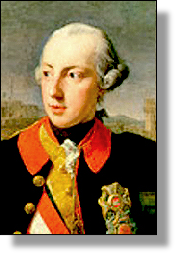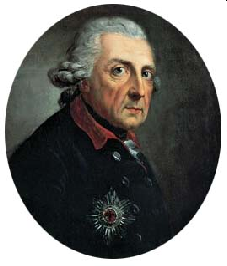


THE WAR OF THE BAVARIAN SUCCESSION 1778 -
xxxxxFollowing the Treaty of Paris of 1763 which concluded the Seven Years' War, the Austrian leader Maria Theresa turned her attention to home affairs, but her son, Joseph, who shared government with her from 1765, had other ideas. In 1772, for example, he took part in the First Partition of Poland with Prussia and Austria, and seized control of Galicia. Then, five years later, he dragged the country into the War of the Bavarian Succession. With this country's throne in dispute, he claimed and invaded Lower Bavaria in 1778. But this was opposed by Frederick the Great of Prussia. He declared war on Austria and the following year, concerned at the turn of events, Maria Theresa wrote to Frederick and sued for peace. The result was the Treaty of Teschen, a diplomatic victory for the Prussians. Austria received but a small strip of Bavaria. In 1785 Joseph made another attempt, this time claiming the whole country, but he was forced to climb down when Frederick formed the League of German Princes against him.
 xxxxxAs we have seen, in the 1740s the redoubtable leader Maria Theresa had managed to hold on to her throne during the War of the Austrian Succession. However, by the Treaty of Aix-
xxxxxAs we have seen, in the 1740s the redoubtable leader Maria Theresa had managed to hold on to her throne during the War of the Austrian Succession. However, by the Treaty of Aix-
 xxxxxThe ruling dynasty of Bavaria came to an end in 1777 with the death of its elector, Maximilian Joseph. The new ruler, the elector of the Palatinate Karl Theodore, without a legitimate heir and with little interest in his newly acquired territory, agreed to a plan proposed by Emperor Joseph by which Lower Bavaria was ceded to Austria. Claiming this area to be land formerly controlled by Austria, Joseph sent in an occupation army. But to Frederick the Great of Prussia (illustrated), anxious as ever to restrict the power of the Habsburgs, this take-
xxxxxThe ruling dynasty of Bavaria came to an end in 1777 with the death of its elector, Maximilian Joseph. The new ruler, the elector of the Palatinate Karl Theodore, without a legitimate heir and with little interest in his newly acquired territory, agreed to a plan proposed by Emperor Joseph by which Lower Bavaria was ceded to Austria. Claiming this area to be land formerly controlled by Austria, Joseph sent in an occupation army. But to Frederick the Great of Prussia (illustrated), anxious as ever to restrict the power of the Habsburgs, this take-
xxxxxThis treaty was a serious check to Joseph's ambitions, but he was not a man to be easily discouraged. In 1785, aiming to extend his heartland at the expense of a distant possession strung along the North Sea, he proposed to Karl Theodore the outright exchange of Bavaria for the Austrian Netherlands. Once again, however, Frederick of Prussia intervened. In July of that year he formed the League of Princes (the Furstenbund), a union of a number of German states which included Hanover and Saxony. This association was pledged to defend the empire and the status quo in Europe. Alarmed at the opposition mounted against him, Joseph climbed down and abandoned the proposed exchange.
xxxxxIncidentally, the war of 1778-
Acknowledgements
Joseph II: detail, by the Italian painter Pompeo Girolamo Batoni (1708-
G3a-


